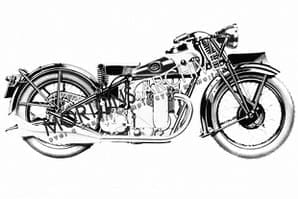
The big Ariel started life as a lithe sportster in an era when big sidecar machines were commonplace, it finished up as one of those self-same heavyweight sidecar tugs in a period when fast solos had become the norm. To help the transformation, its capacity was doubled along the way – making it by far the biggest home market motorcycle – and its sporty overhead cam valve operation had been replaced by conventional pushrods.
Model descriptions and production years follow.
Enjoy more Classic MotorCycle reading in the monthly magazine.
Click here to subscribe & save.
1930 Ariel Square Four
Launched in November 1930, the Ariel Square Four was a true revelation. Designed by the mercurial Edward Turner, it was like nothing else which had reached the market and although there were compromises on the production version – such as the prototype had its gearbox in unit with the engine – the basic layout remained the same.
1932 Ariel Square Four
The 600cc 4F was announced for the 1932 model season. Capacity was increased to 601cc, achieved by increasing the cylinder bore by 5mm, to 56mm. Otherwise, the model remained much as Turner’s original 1930-launched machine, and the 600cc ‘cammy’ version stayed in production until 1937.
1937 Ariel Square Four prototype
Though a prototype 600cc overhead valve version had been developed in conjunction with the 1000cc version, it wasn’t listed until 1939. Bore size for the new 600 was 50.4mm, while the stroke remained unchanged from the 1000cc version, at 75mm. Though it weighed the same (a tubby 420lb) as the litre version, it had 13bhp less, at 23bhp.
1939 Ariel Square Four
Edward turner had designed an overhead valve version of the Square Four in 1935, and although a pre-production model was running as early as mid-1936, it was 1937 before the ‘new’ model began to appear in the showrooms. By the time ohv Squariels were being delivered, Turner had left for Triumph, replaced by Frank Anstey.
Ariel Square Four 1951
Postwar the Square Four was updated, initially mainly with telescopic forks replacing the prewar girders. The Mark I 4G (for 1949) saw the cast iron clyinder block and head replaced with an alloy one, while there was also a switch to coil ignition. All in all, the amount of weight saved was a not inconsequential 32lb.
1954 Ariel Square Four
Last of the line was the MKII, or ‘four piper’ as it was otherwise known. Offically designated the 4G Mark II, it was launced for the 1953 season. An SU carburettor was fitted from 1954, a headlamp cowl in 1956 and cast-aluminium full-width hubs the same year. The end came in August 1959.
Riding experience
“The early and late square fours feel very different to ride, much of it down to the respective physical sizes of them. They are united by their smoothness, and while the later machine is obviously quicker, the early one feels appreciably more nimble. Square fours do sound brilliant, too, which is another bonus to ownership.”
Visit the Mortons Archive for more information and online search options concerning Ariels, or speak to our archivist Jane Skayman on 01507 529423 with your requirements. Email [email protected] ![]()
Other articles in the 'which model' series:
? BSAs
? BSA A10s
? BSA Bantam
? Cammy Norton Singles
? Norton Commando
? Norton ES2
? Triumph Thunderbird
? Velocette LE
Advert
 Enjoy more The Classic MotorCycle reading in the monthly magazine. Click here to subscribe.
Enjoy more The Classic MotorCycle reading in the monthly magazine. Click here to subscribe.



